Making Enclosures for Books and Paper Objects – Canadian Conservation Institute (CCI) Notes 11/1
Disclaimer
The information in this document is based on the current understanding of the issues presented. It does not necessarily apply in all situations, nor do any represented activities ensure complete protection as described. Although reasonable efforts have been made to ensure that the information is accurate and up to date, the publisher, Canadian Conservation Institute (CCI), does not provide any guarantee with respect to this information, nor does it assume any liability for any loss, claim or demand arising directly or indirectly from any use of or reliance upon the information. CCI does not endorse or make any representations about any products, services or materials detailed in this document or on external websites referenced in this document; these products, services or materials are, therefore, used at your own risk.
Introduction
Storage is the first defense in protecting books and paper objects from agents of deterioration such as dissociation, water and incorrect relative humidity (more specifically, fluctuations in relative humidity). A properly sized enclosure will protect a book or paper object from damage while retaining detached pieces and protecting your object during future handling.
This Note outlines three simple enclosures:
- A basic slipcase for books
- A box for archival materials, books and matted works of art on paper
- A portfolio for small pamphlets, booklets, documents, manuscripts and unmatted works of art on paper
Considerations
Because most papers and boards are acidic and can therefore damage objects, enclosures for objects should be made from acid-free materials. Papers and boards are typically made from highly purified chemical wood pulp, though they are sometimes made entirely of “rag paper,” which is paper made from cotton or linen rags. The term “acid-free” refers to paper products that tested at a neutral pH, while the terms “buffered” or “alkaline” refer to paper products that have been buffered with an alkaline reserve. Buffering can offer additional protection against acids over the long term. Note that certain types of paper objects, such as cyanotypes (blueprints) and diazotypes (whiteprints), are sensitive to higher pH levels and should therefore be stored in acid-free, unbuffered enclosures.
It is important to note that the term “archival” can be used by manufacturers to advertise products that are not considered safe for long-term storage. It is not a meaningful term in and of itself.
Acid-free envelopes and boxes can be bought as needed from suppliers. However, it is sometimes better to construct your own simple, custom-designed enclosures for specific objects. This ensures a more precise fit and better protection.
Before selecting an enclosure type, examine each object carefully. Individual archival documents, manuscripts and unmatted works of art are best stored in an envelope, a portfolio or a simple four-flap enclosure. Books in good physical condition can be stored in a slipcase, but fragile or badly damaged books are more suitably stored in a box: either a simple box as illustrated in this Note, a phase box or a clamshell box. A slipcase can be useful in historic book collections where the spines need to be visible, but it does not protect a book from light damage, for example, while a custom-built phase box or “tuxedo” box would. Modified slipcases known as “book shoes” can be very useful to support large or heavy bindings that may be sagging on the shelf with the force of gravity. Consult the Further reading section for resources on how to make a book shoe, as well as other enclosures for books and paper objects.
Equipment and materials
- Metal ruler
- Sharp knife
- Cutting mat
- 2-ply or 4-ply acid-free matboard
- Sturdy, acid-free paper, such as Permalife (80 lb or 60 g/m2)
- 4 cm gummed linen tape (acid-free) and 3M #415 double-sided tape
- Poly(vinyl acetate) (PVAC) adhesive (such as Jade 403) or double-sided tape (3M #415)
General instructions
Each enclosure takes approximately one hour to construct.
Things like loose newspaper clippings, pressed botanicals or papers can be left in situ if they are considered part of the object or they can be placed in a paper folder or inert polyester envelope and stored with the object. In the case of books, detached binding materials can also be put in an envelope to keep items together.
Prepare objects for storage by considering whether you need to remove items from the following list:
- All types of plastic that are not part of the object (for example, rubber bands or plastic wrappings)
- Envelopes, brown paper bags, loose cardboard backings and newspaper wrappings
- Staples, paper clips, pins and any other metal attachments
- Loose dust and dirt
Measure the object (height, width and depth) in millimetres. To measure the depth of a book, measure the thickness at both the spine and fore-edge and use the larger measurement. Add 3 mm around all edges and use these dimensions to draw the design for the slipcase, box or portfolio on matboard or on paper. Cut out the pattern.
When matboard is used, score along the fold lines (shown as dotted lines in Figures 1a, 1b, 2 and 3a) with a sharp knife to make folding easier.
Use gummed linen tape to secure corners and to strengthen folds. If additional strengthening is necessary, use bookbinding cloth or paper to cover the enclosure.
Slipcase
This open-sided box, made of 2-ply or 4-ply acid-free matboard, is designed to hold books that require support and protection (Figures 1a and 1b). The open side leaves the spine visible so that the book can be identified. The scored extension flaps fold up. The flaps are held together with either PVAC adhesive, such as Jade 403, or double-sided tape (3M #415). If the book has detached boards and is tied using cotton twill tape to retain the boards, ensure that the tape is tied at the fore-edge. In Figure 1a, the letters and numbered flaps represent the following information:
- A. The height and width of the book plus 3 mm around all edges (flaps 1 and 3 are the same width as A.)
- B. The depth (thickness) of the book plus 3 mm (flaps 1 and 3 are the same height as the width of B; flaps 2 are the same width as B and are cut to half the height of flaps 1 and 3.)
- C. The board is scored to half its width.
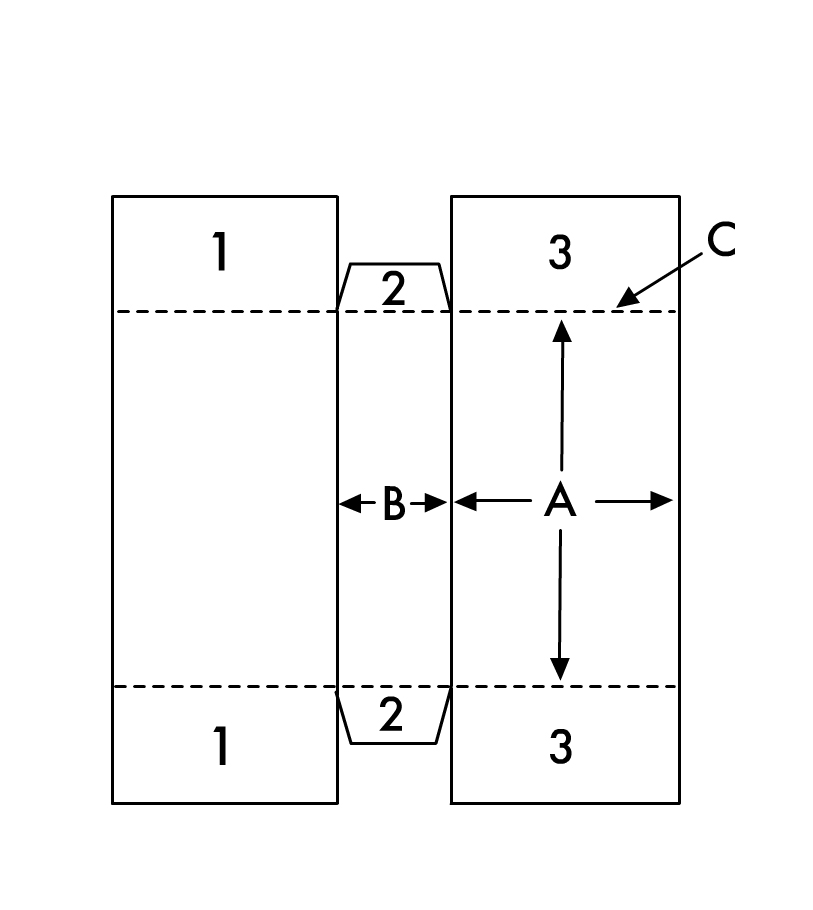
© Government of Canada, Canadian Conservation Institute. 136444-0001
Figure 1a. Pattern for the slipcase.
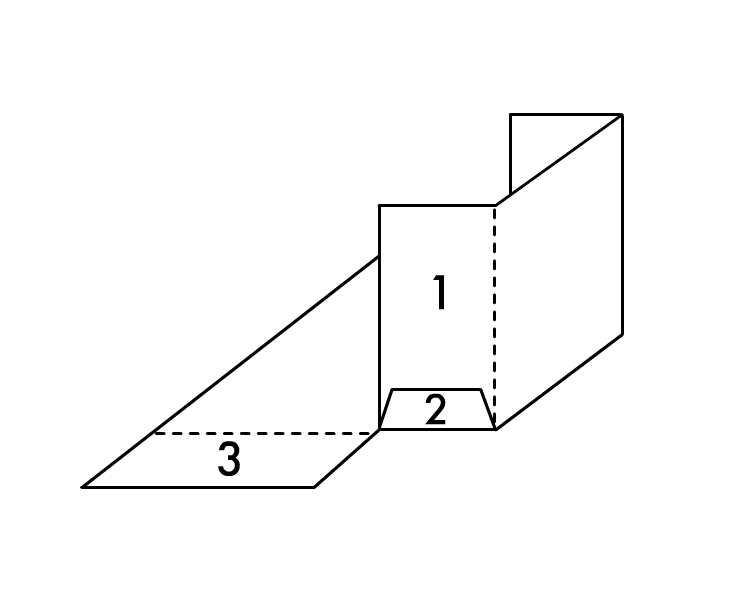
© Government of Canada, Canadian Conservation Institute. 136444-0002
Figure 1b. Assembling the slipcase: the numbers on the flaps denote the assembly sequence.
Box
This very simple box can be used to store archival materials, books and matted works of art on paper (Figure 2). Depending on the size required, boxes can be made of 2-ply or 4-ply acid-free matboard.
In Figure 2, the letters represent the following information:
- A. Bottom of the box (dimensions of the book plus 3 mm around all edges)
- B. Top of the box (5 mm larger around all edges than the bottom)
- C. Depth of the book plus 3 mm
- D. Corners removed
- E. Board scored to half its depth
- F. Top of the box (side view)
- G. Bottom of the box (side view)
- H. Gummed linen tape at outer corners of both top and bottom of box

© Government of Canada, Canadian Conservation Institute. 136444-0003
Figure 2. Construction of a box.
Portfolio
A portfolio is used to store small pamphlets, booklets, documents, manuscripts and unmatted works of art. It consists of an acid-free, folded-paper envelope (Figure 3a) that contains the object and an outer cover made of two pieces of 4-ply acid-free matboard hinged along the spine (Figure 3b). The two parts are made separately and then joined together (Figure 3c) with either PVAC adhesive (used sparingly around the edges) or double-sided tape.
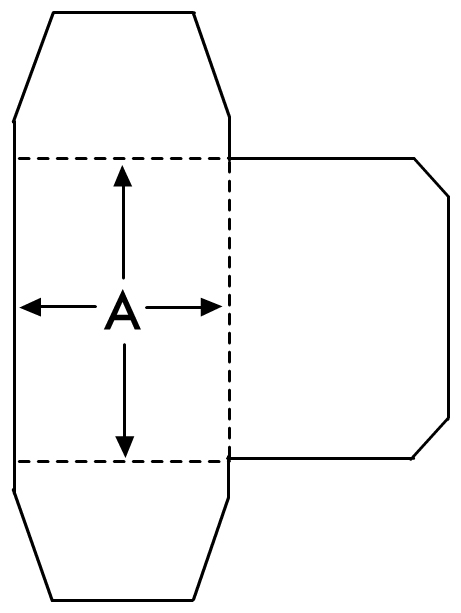
© Government of Canada, Canadian Conservation Institute. 136444-0004
Figure 3a. Pattern for the portfolio’s inner envelope: A. Dimensions of the object plus 3 mm around all edges.
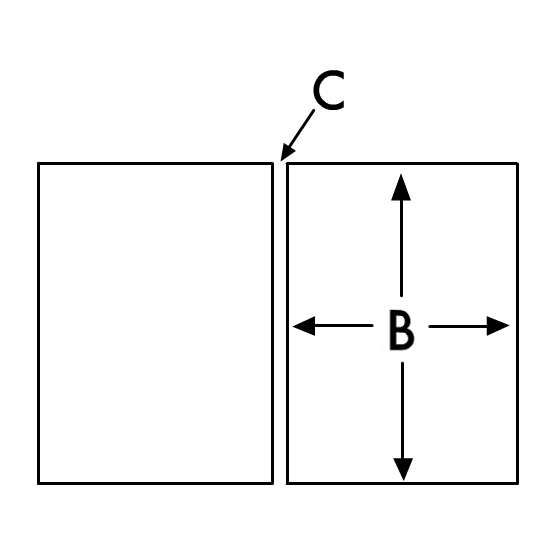
© Government of Canada, Canadian Conservation Institute. 136444-0005
Figure 3b. Pattern for the portfolio’s outer cover: B. Outer cover (3 mm larger around all edges than the inner envelope); and C. Space allowed for thickness of the matboard.
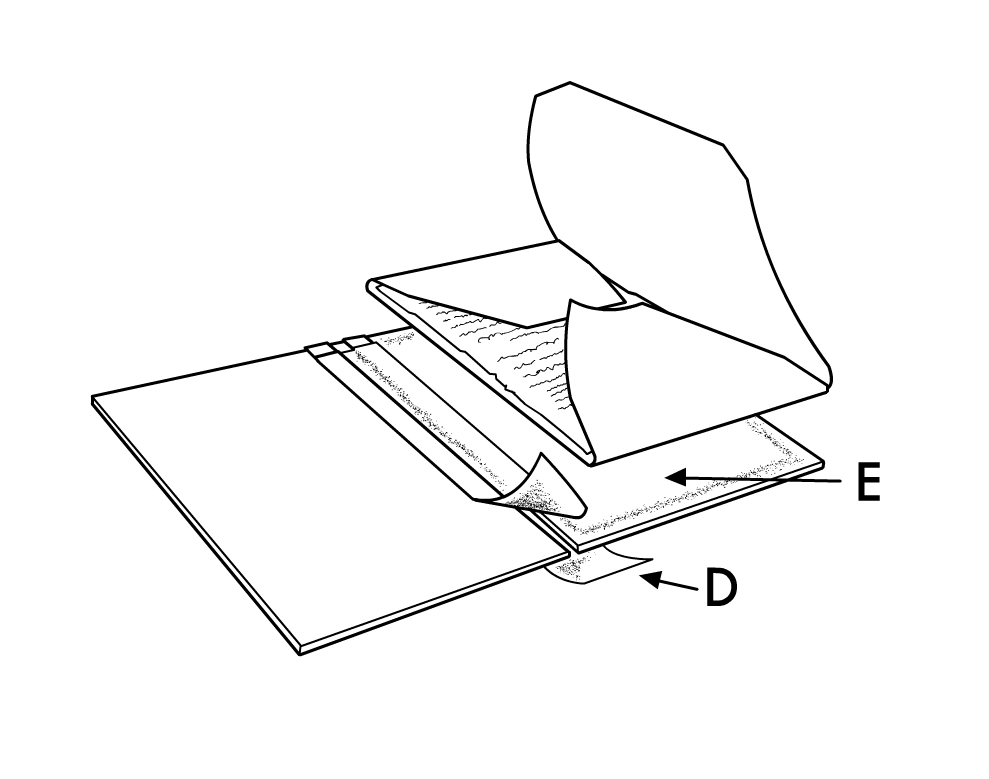
© Government of Canada, Canadian Conservation Institute. 136444-0006
Figure 3c. Assembling the portfolio: D. Gummed linen tape or bookbinding cloth; and E. Attach envelope to cover with either PVAC adhesive or double-sided tape.
Conclusion
An enclosure can extend the life of books and paper objects. Enclosures do not need to be complicated, and there are many different options that can be built or purchased. The most important aspect to remember is to use good quality materials in your enclosures and to consider how to best protect your books or paper objects within their own particular context.
Suppliers
Materials can be purchased through suppliers specializing in library, archival, art and conservation products.
Canadian suppliers
UK suppliers
USA suppliers
Further reading
American Institute for Conservation (AIC). Photographic Materials Group Wiki – Preservation Housing Materials and Formats, AIC, 2025.
Bibliothèque nationale de France. Ressources en conservation du patrimoine écrit et numérique: Fiches techniques (in French only), [n.d.]
Brown, M. Boxes for the Protection of Rare Books: Their Design and Construction. Washington, DC: Library of Congress, 1982.
Clarkson, C., “The Book Shoe: description & uses.” Libraries Bulletin (Oxford University) 42 (1984) pp. 4–7.
Clarkson, C., and H. Lindsay. “Housing Single-sheet Material: The Development of the Fascicule System at the Bodleian Library, Oxford.” The Paper Conservator 18 (1994), pp. 40–48.
Cullhed, P. “The 5-Minute Phase Box.” Abbey Newsletter 24, 2 (2000).
Elder, R. "Making a Four Flap Enclosure for Library and Archival Materials [Tutorial]." The Sustainable Heritage Network, 2025.
Hannington, D., and C. McNair. Basic Care of Books, revised. CCI Notes 11/7. Ottawa, ON: Canadian Conservation Institute, 2022.
Hannington, D., and C. McNair. Display Methods for Books, revised. CCI Notes 11/8. Ottawa, ON: Canadian Conservation Institute, 2022.
Honey, A. “Housing Single-sheet Material: ‘Fishering’ at the Bodleian Library, Oxford.” The Paper Conservator 28, 1 (21 September 2010), pp. 99–104.
Lemay, M. Notion de conservation préventive (PDF format; in French only). Montréal, QC: Centre de Conservation du Québec, 2011.
Mesmer, R. “Tips: Materials and Techniques for Mounts, Encapsulations, and Book Supports.” The Book and Paper Group Annual 32 (2013), pp. 84–87.
Ministère de la Culture et des Communications, Gouvernement du Québec. Préserv'Art (in French only). Montréal, QC: Centre de Conservation du Québec, 2023.
Northeast Document Conservation Center (NEDCC). 4.7 The Book Shoe: Description and Uses. Preservation Leaflets series. Andover, MA: NEDCC, 1999.
Northeast Document Conservation Center (NEDCC). 4.9 Storage Solutions for Oversized Paper Artifacts. Preservation Leaflets series. Andover, MA: NEDCC, 1999.
Northeast Document Conservation Center (NEDCC). 5.5 Storage Enclosures for Photographic Materials. Preservation Leaflets series. Andover, MA: NEDCC, 2018.
Northeast Document Conservation Center (NEDCC). 7.4 Custom Protective Enclosures. Preservation Leaflets series. Andover, MA: NEDCC, 2018.
Northeast Document Conservation Center (NEDCC). 7.8 Removal of Damaging Fasteners from Historic Documents. Preservation Leaflets series. Andover, MA: NEDCC, 2020.
Smith, W. “The Ferguson Slipcase.” Abbey Newsletter 13, 5 (September 1989).
Stokoe, D., and Department of Preservation and Conservation. “Tuxedo” Phase Box (3 variants) (PDF format). SURFACE Syracuse University: Libraries’ and Librarians’ Publications 96, 2012.
Ullman Classics Library. Four-flap Enclosures, 2023.
First edition by the Department of Canadian Heritage (1996); originally published as Making Protective Enclosures for Books and Paper Artifacts
Second edition by Christine McNair (2025)
© Government of Canada, Canadian Conservation Institute, 2025
Cat. No.: NM95-57/11-1-2025E-PDF
ISSN 1928-1455
ISBN 978-0-660-79625-3